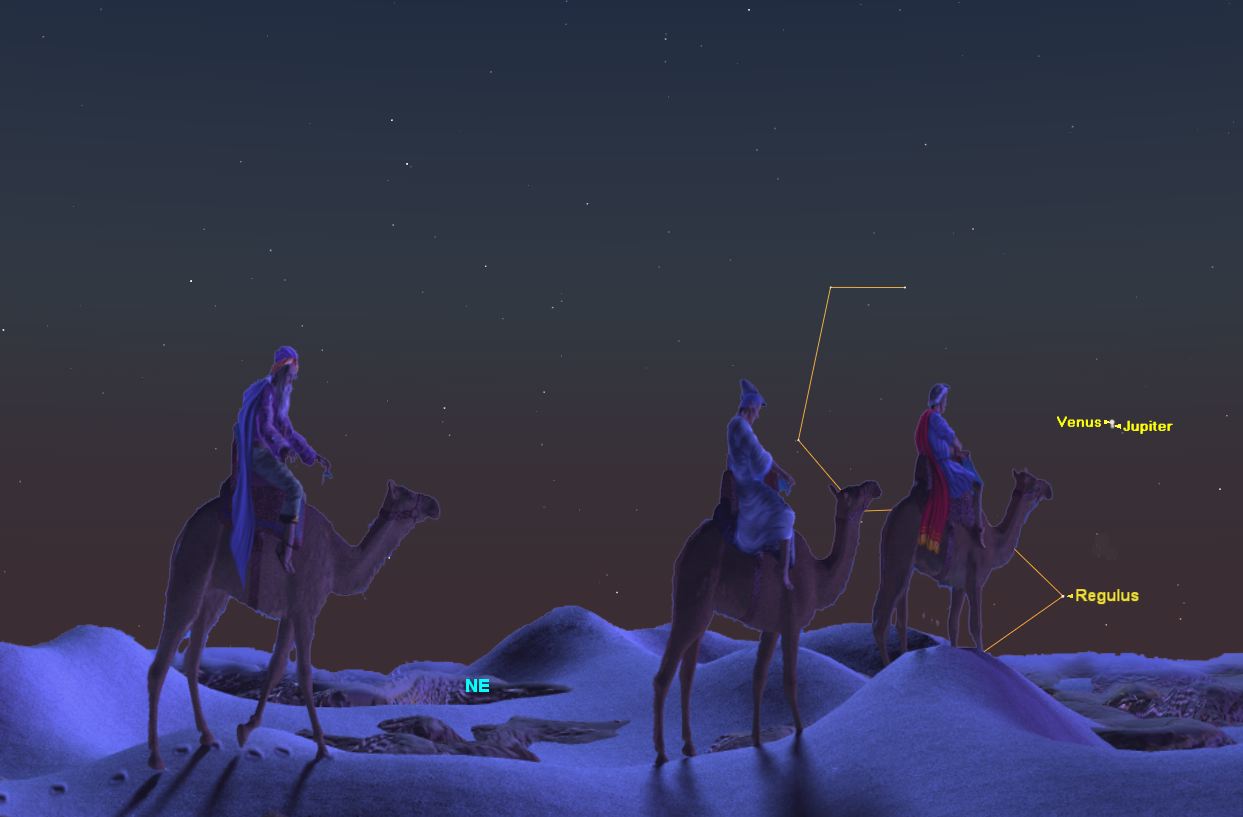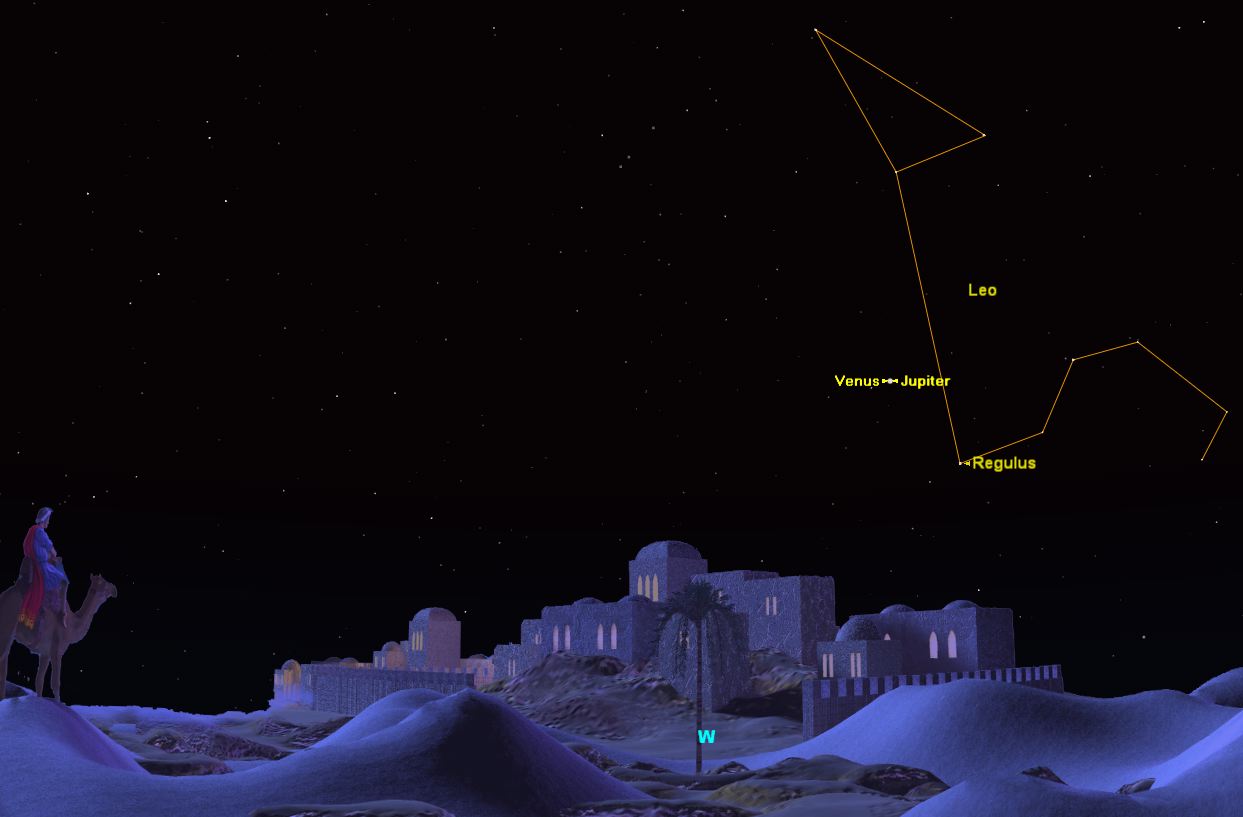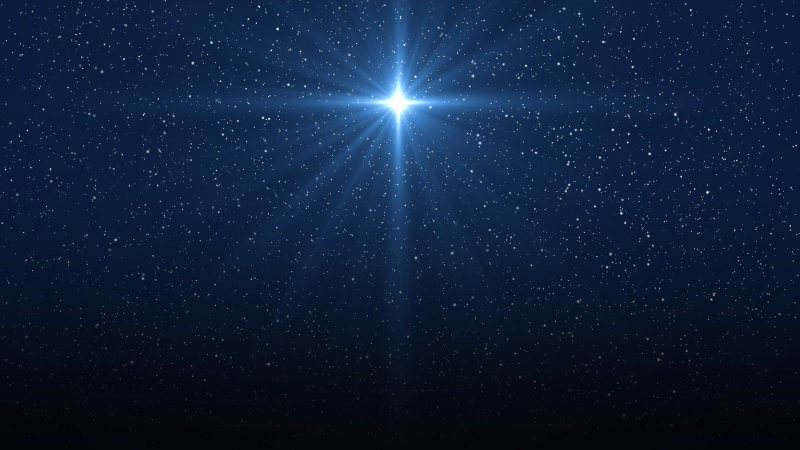For many decades, planetariums around the world have presented holiday programs centering on the astronomical possibilities for explaining the mysterious Star of Bethlehem, which Matthew describes enigmatically in his gospel. Eastern University has given a program on this topic each year since 1972, and the following is a very brief summary of the ideas and possible scientific explanation for what this phenomenon might have been which led the wise men or Magi to the Christ Child about 2000 years ago.
Pinpointing the time in order to determine the star of Bethlehem
The first problem is dating the birth of Jesus so that we know what skies to investigate for celestial phenomena. This is perhaps the most controversial area of this topic. What we know for certain is that Jesus was not born on December 25th in the year 0, because there was no year zero! In 525 AD, Dionysius Exiguus established the year system which we use today based on his best estimates of Jesus’ birth as taking place 754 years after the founding of Rome. He placed Jesus’ birth in what we now call 1 BC, or Before Christ, and the year immediately following 1 BC was 1 AD, or Anno Domini, which means “in the year of our Lord.” Using the zero in number counting systems was introduced by the Arabs in the seventh century and was not known in Dionysius’ time. The December 25th date was the date of the winter solstice (or first day of winter) in ancient times. The word “solstice” literally means “sun standing still” and marked the day when the sun stopped decreasing in noontime altitude and would then begin to make its slow rise through the next six months until it reached its highest point at noon in the sky, called the summer solstice. This time of year marked the celebration of the pagan festival of the Saturnalia, when folks would celebrate the fact that the sun wouldn’t keep decreasing in noontime altitude, and the promise of spring’s return caused them to have hope to make it through the coming winter months. Celebratory events like exchanging gifts, slaves taking the place of their masters for a day, feasts and other more tawdry expressions took place at this time!
In fact, December 25th was officially declared to be the birthday of Jesus by the Catholic church in 336 AD (with no reason given), most likely to take over this pagan celebration time since so many were used to celebrating at this time of year. The celebrations which took over this festival became so rowdy and drunken that Christmas was not celebrated universally in the United States like we celebrate it today until the late 19th century!
The passage in Luke 2:8 mentions that shepherds were out watching their flocks at night when Jesus was born. Shepherds watched their flocks at night from March through November — in other words, all year long except the winter months. So we can be quite certain that Jesus was not born on December 25th!
If we attempt to narrow down the year of Jesus’ birth using biblical clues, we have clues from Matthew 2:1a, where we are told that Jesus was born during the reign of Herod. The Jewish historian Josephus tells us that Herod died shortly after an eclipse of the moon but before the next Jewish Passover. Most scholars have accepted that the eclipse that Josephus mentions is the partial and unimpressive lunar eclipse of March 13, 4 BC. This would mean that Jesus was probably born before 4 BC, most likely in 7-6 BC. Recent historical investigations have suggested that perhaps the lunar eclipse that Josephus was describing was the total and much more prominent lunar eclipse of January 9, 1 BC, with the Passover occurring on April 8th of that year.
Let’s assume that Jesus was born sometime prior to January 1 BC, perhaps in 3-2 BC. Were there any interesting celestial events that could fit Matthew’s descriptions of the Star of Bethlehem? Matthew 2:2 relates that the Magi visited Herod in Jerusalem to ask him where the King of the Jews was to be born, as they had witnessed “His star in the east.” It is unclear whether they meant that they had seen the star while they were in the east or that the star itself was in the east. Herod and his advisors had absolutely no clue that anything unusual was taking place in the heavens but conveyed to the Magi that the Messiah was prophesied to be born in Bethlehem. Herod sent them to Bethlehem to search for the child and told them to report back what they found — ostensibly to allow him to worship Him as well — but obviously he meant to destroy Him. The wise men headed toward Bethlehem and were astonished to see the star again, and it purportedly led them directly to the Christ Child. After giving Him their gifts (symbolic of a king, priest and burial spices) they returned to their homeland by another way to avoid Herod.
How the Three Wise Men could have interpreted the star of Bethlehem
What celestial event(s) could explain this? Of course, an unexplainable miracle could have occurred, but is it possible that these wise men saw something in the heavens that everyone could have noticed but only a few learned people could have correctly interpreted? After all, Herod and his advisors had seen nothing in the skies that drew their attention, and yet the Magi saw it twice! Were there two unusual occurrences in the skies of 3-2 BC that would have fit this bill? The answer is possibly yes! When wandering stars, called planets, move in the sky, they can eventually come close together in an event called a “conjunction.” These were not rare, but in 3 and 2 BC there were two conjunctions that the wise men would never have seen before in their lifetimes, and the constellation in which they occurred may have tipped them off that something of importance was taking place in Judea.

In August of 3 BC Venus and Jupiter, the two brightest planets, came very close together in the early morning eastern sky just before the sun rose in the constellation Leo the Lion near the bright star Regulus. Regulus was known as the royal star (see the root word “regal” in its name), and Jupiter was the king of the gods. Venus was the goddess of love, and Leo was associated with the Jewish nation (the Lion of Judah). So perhaps this very close conjunction of the two brightest planets in the eastern sky suggested to the wise men that a King was to be born in Judea. They then traveled for an unknown period of time and eventually arrived in Jerusalem to query the local officials about where this King was to be born. Then, they headed toward Bethlehem as instructed by Herod’s advisors. But lo and behold, the star appeared again! How can this be explained?
Well, interestingly in June of 2 BC, 10 months after the initial conjunction of Jupiter and Venus, there was yet another conjunction of these very same planets near Regulus in Leo, but this time the conjunction occurred in the early evening sky visible near the western horizon! This coupling of these bright planets was so close that, for a few brief hours, they would have merged to appear like one bright star! Perhaps it was this second conjunction which Matthew relates as when the Magi saw the star again when they headed toward Bethlehem.

Obviously, we cannot know for sure what that star was, but the above scenario would certainly explain a great deal. But the important thing is that the wise men sought for and found the Christ Child, and He is still there for all of us to find! The star, whatever it was, symbolizes for all of us that Guiding Light which leads all who search for Him to the Light of the World. And isn’t that what Christmas is all about?




